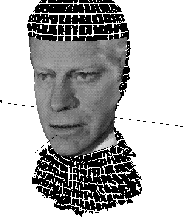 |
![[*]](http://vismod.www.media.mit.edu/vismod/support/latex2html-98//cross_ref_motif.gif) , can then be computed. Each point in the 3D
object undergoes this transformation to determine its locus relative to the 2D
image. Essentially, the 3D object's range data points are rotated, translated
and stretched to superimpose the 2D face's intensity points. It is then
possible to compute the projection of the 3D range model onto the 2D plane and
to associate each of its range data points with a corresponding 2D plane
point. Each projected 3D range point can then be ``colorized'' by the
intensity value of the 2D plane point (or pixel) it intersects. The end result
is a 3D model which is ``coated'' with the textural data of the face in the 2D
image (see Figure
, can then be computed. Each point in the 3D
object undergoes this transformation to determine its locus relative to the 2D
image. Essentially, the 3D object's range data points are rotated, translated
and stretched to superimpose the 2D face's intensity points. It is then
possible to compute the projection of the 3D range model onto the 2D plane and
to associate each of its range data points with a corresponding 2D plane
point. Each projected 3D range point can then be ``colorized'' by the
intensity value of the 2D plane point (or pixel) it intersects. The end result
is a 3D model which is ``coated'' with the textural data of the face in the 2D
image (see Figure ![[*]](http://vismod.www.media.mit.edu/vismod/support/latex2html-98//cross_ref_motif.gif) ).
).